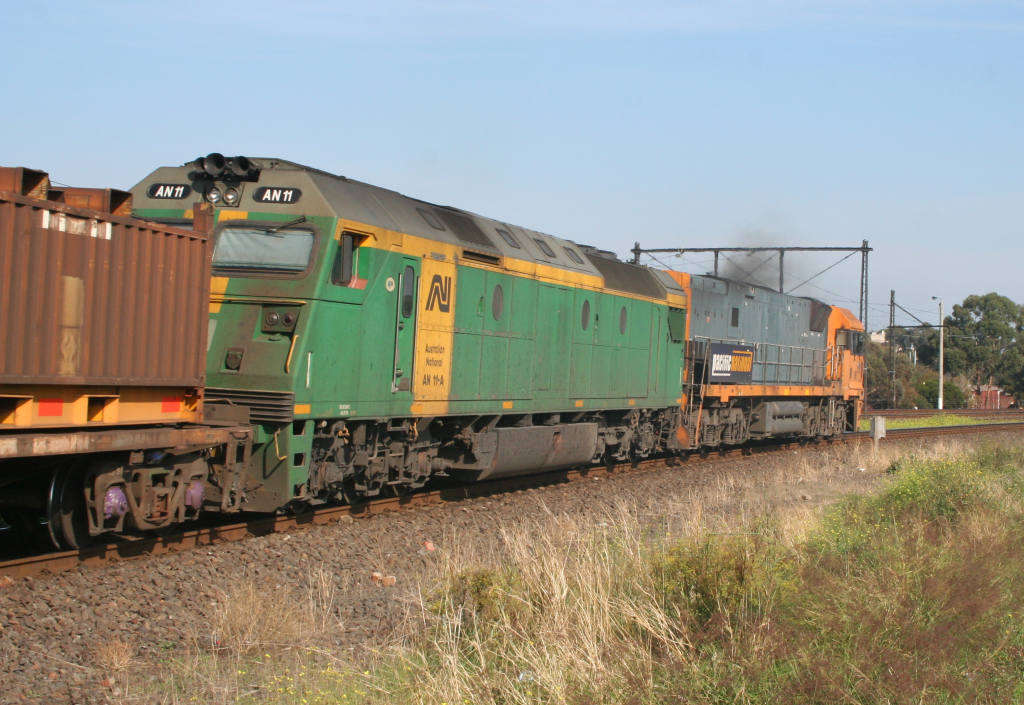- AN class
Infobox Locomotive

imagesize=250
name= AN Class
caption=AN11 in Australian National livery trails anNR class locomotive
powertype=Diesel-electric
gauge=RailGauge|ussg
builder=General Motors Electro-Motive Division (EMD), Clyde Engineering
buildmodel=EMD JT46C
builddate=1992 –1993
aarwheels=C-C
cylindercount=16
primemover=EMD 16-710G3A
poweroutput=4,120 hp
length=74 ft 1 in (22.60 m)
totalproduction=11
weight=128.00t
tractionmotors=EMD D87BTR
generator=EMD AR11
topspeed=150km/h
tractiveeffort=(Continuous) 323 kN at 26 km/h
railroad=1992 - Current
railroadclass=AN
numinclass=11 (10 in service)
roadnumber=AN1 - AN11
locale=Australia
retiredate=0
preservedunits=0
scrapdate=1
currentowner=Pacific National The AN class are an
Australia n diesel electric locomotives ordered byAustralian National Rail Commission in 1991. 11 in number, these "JT46C" locomotives from the Electro-Motive Division (EMD) of General Motors were for use on flagship intercapital freight services. Introduced to service in1992 , they were bodied byClyde Engineering at theirSomerton, Victoria plant using EMD and local components. As the railway's flagship class, and their first new acquisition, they locomotives were allocated the "AN" class identifier.The AN Class were the most powerful locomotives in the Australian National fleet, their 16-cylinder
EMD 710 prime mover producing up to 4120horsepower - which also makes them some of the most powerful locomotives inAustralia . By contrast, the flagshipNR class of Australian National's successor company National Rail produce only 4,080horsepower .When Australian National was broken up in 1992, the AN Class (numbering only 3 in-service locomotives at the time) were transferred to successor company National Rail, with whom they operated for until
2001 . They were then passed on toPacific National after National Rail's merger with FreightCorp and privatisation. Nowadays AN class locomotives can be seen anywhere around Australia, but they are usually confined to the Sydney-Adelaide-Perth corridor, or as trailing units on Melbourne-Adelaide services.The class was originally painted in the Australian National corporate scheme. Many now wear National Rail's grey and orange livery, while the Australian National livery still remains on a number of units. AN 5 is the only locomotive which wears the Pacific National scheme, with most just having decals over the National Rail logo (where the unit wears the National Rail livery). AN3 is painted in
The Ghan livery, for use leading GSR's "The Ghan" service.All members of the AN class remain in service, except for AN10, which was scrapped along with DL37 after the Hines Hill collision.
References
* cite web
url=http://locopage.railpage.org.au/anr/an.html
title=AN: AN Class
publisher=locopage.railpage.org.au
accessdate=2008-05-17
* cite web
url=http://vicsig.net/index.php?page=locomotives&class=AN&orgstate=A&type=Diesel-Electric
title=VICSIG - AN class
publisher=vicsig.net
accessdate=2008-05-17
Wikimedia Foundation. 2010.
